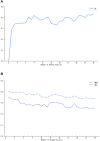Predicting Blood Concentration of Tacrolimus in Patients With Autoimmune Diseases Using Machine Learning Techniques Based on Real-World Evidence
- PMID: 34630104
- PMCID: PMC8497784
- DOI: 10.3389/fphar.2021.727245
Predicting Blood Concentration of Tacrolimus in Patients With Autoimmune Diseases Using Machine Learning Techniques Based on Real-World Evidence
Abstract
Tacrolimus is a widely used immunosuppressive drug in patients with autoimmune diseases. It has a narrow therapeutic window, thus requiring therapeutic drug monitoring (TDM) to guide the clinical regimen. This study included 193 cases of tacrolimus TDM data in patients with autoimmune diseases at Southern Medical University Nanfang Hospital from June 7, 2018, to December 31, 2020. The study identified nine important variables for tacrolimus concentration using sequential forward selection, including height, tacrolimus daily dose, other immunosuppressants, low-density lipoprotein cholesterol, mean corpuscular volume, mean corpuscular hemoglobin, white blood cell count, direct bilirubin, and hematocrit. The prediction abilities of 14 models based on regression analysis or machine learning algorithms were compared. Ultimately, a prediction model of tacrolimus concentration was established through eXtreme Gradient Boosting (XGBoost) algorithm with the best predictive ability (R 2 = 0.54, mean absolute error = 0.25, and root mean square error = 0.33). Then, SHapley Additive exPlanations was used to visually interpret the variable's impacts on tacrolimus concentration. In conclusion, the XGBoost model for predicting blood concentration of tacrolimus on the basis of real-world evidence has good predictive performance, providing guidance for the adjustment of regimen in clinical practice.
Keywords: autoimmune disease; blood concentration prediction; machine learning; tacrolimus; therapeutic drug monitoring.
Copyright © 2021 Zheng, Yu, Li, Liu, Lou, Hao, Yu, Lei, Qi, Wang, Gao, Zhang and Li.
Conflict of interest statement
Author ZY, PY, QQ, ZW, and FG were employed by Beijing Medicinovo Technology Co. Ltd. Author XH is employed by Dalian Medicinovo Technology Co. Ltd. The remaining authors declare that the research was conducted in the absence of any commercial or financial relationships that could be construed as a potential conflict of interest.
Figures




Comment in
-
Commentary: Predicting blood concentration of tacrolimus in patients with autoimmune diseases using machine learning techniques based on real-world evidence.Front Pharmacol. 2022 Nov 3;13:1000476. doi: 10.3389/fphar.2022.1000476. eCollection 2022. Front Pharmacol. 2022. PMID: 36408265 Free PMC article. No abstract available.
Similar articles
-
Developing a machine learning model for predicting venlafaxine active moiety concentration: a retrospective study using real-world evidence.Int J Clin Pharm. 2024 Aug;46(4):899-909. doi: 10.1007/s11096-024-01724-y. Epub 2024 May 16. Int J Clin Pharm. 2024. PMID: 38753076
-
A machine learning model for predicting blood concentration of quetiapine in patients with schizophrenia and depression based on real-world data.Br J Clin Pharmacol. 2023 Sep;89(9):2714-2725. doi: 10.1111/bcp.15734. Epub 2023 May 7. Br J Clin Pharmacol. 2023. PMID: 37005382
-
A Prediction Model for Tacrolimus Daily Dose in Kidney Transplant Recipients With Machine Learning and Deep Learning Techniques.Front Med (Lausanne). 2022 May 27;9:813117. doi: 10.3389/fmed.2022.813117. eCollection 2022. Front Med (Lausanne). 2022. PMID: 35712101 Free PMC article.
-
Pharmacokinetic optimization of immunosuppressive therapy in thoracic transplantation: part I.Clin Pharmacokinet. 2009;48(7):419-62. doi: 10.2165/11317230-000000000-00000. Clin Pharmacokinet. 2009. PMID: 19691367 Free PMC article. Review.
-
Therapeutic drug monitoring of immunosuppressive drugs in hepatology and gastroenterology.Best Pract Res Clin Gastroenterol. 2021 Oct-Dec;54-55:101756. doi: 10.1016/j.bpg.2021.101756. Epub 2021 Jun 16. Best Pract Res Clin Gastroenterol. 2021. PMID: 34874840 Review.
Cited by
-
A novel machine learning model to predict high on-treatment platelet reactivity on clopidogrel in Asian patients after percutaneous coronary intervention.Int J Clin Pharm. 2024 Feb;46(1):90-100. doi: 10.1007/s11096-023-01638-1. Epub 2023 Oct 10. Int J Clin Pharm. 2024. PMID: 37817027
-
Machine learning advances the integration of covariates in population pharmacokinetic models: Valproic acid as an example.Front Pharmacol. 2022 Oct 17;13:994665. doi: 10.3389/fphar.2022.994665. eCollection 2022. Front Pharmacol. 2022. PMID: 36324679 Free PMC article.
-
Discussion on machine learning technology to predict tacrolimus blood concentration in patients with nephrotic syndrome and membranous nephropathy in real-world settings.BMC Med Inform Decis Mak. 2022 Dec 20;22(1):336. doi: 10.1186/s12911-022-02089-w. BMC Med Inform Decis Mak. 2022. PMID: 36539772 Free PMC article.
-
An interpretable stacking ensemble learning framework based on multi-dimensional data for real-time prediction of drug concentration: The example of olanzapine.Front Pharmacol. 2022 Sep 27;13:975855. doi: 10.3389/fphar.2022.975855. eCollection 2022. Front Pharmacol. 2022. PMID: 36238557 Free PMC article.
-
Interpretable machine learning model to predict surgical difficulty in laparoscopic resection for rectal cancer.Front Oncol. 2024 Feb 6;14:1337219. doi: 10.3389/fonc.2024.1337219. eCollection 2024. Front Oncol. 2024. PMID: 38380369 Free PMC article. Review.
References
-
- Aha D. W., Kibler D., Albert M. K. (1991). Instance-based Learning Algorithms. Mach. Learn. 6, 37–66. 10.1007/bf00153759 - DOI
-
- Andrews L. M., Li Y., De Winter B. C. M., Shi Y. Y., Baan C. C., Van Gelder T., et al. (2017). Pharmacokinetic Considerations Related to Therapeutic Drug Monitoring of Tacrolimus in Kidney Transplant Patients. Expert Opin. Drug Metab. Toxicol. 13 (12), 1225–1236. 10.1080/17425255.2017.1395413 - DOI - PubMed
-
- Breiman L. (2001). Random Forests. Mach. Learn. 45, 5–32. 10.1023/a:1010933404324 - DOI
LinkOut - more resources
Full Text Sources

